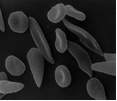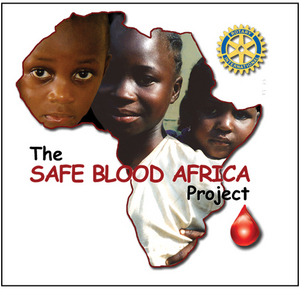Tag Archive: Stanford blood
November 4, 2011 at 11:10 am
Published by Stanford Blood Center

By Billie Rubin, Hemoglobin's Catabolic Cousin, reporting from the labs of Stanford Blood Center
Sickle cells are abnormally shaped red blood cells (RBCs) caused by a mutation of the hemoglobin gene (Hgb S). Their less flexible, sickle-like shape leaves them unable to get through small capillaries, resulting in obstructed blood vessels in many organs. In addition, because of this sickle shape, the RBCs are sequestered and destroyed in the spleen at a faster rate than normal cells.
October 28, 2011 at 10:14 am
Published by Stanford Blood Center

By Julie Ruel, Social Media Manager, Stanford Blood Center
Each day, the recruitment team at Stanford Blood Center (SBC) works hard to help ensure we have blood products available to those in need. "We do this by connecting with donors and inviting them to return. It sounds simple enough, but the reality is that this mission takes time, strategy, and creativity," explains Karen Paganelli, recruitment manager at SBC. The hospitals' needs fluctuate from day to day and we must constantly keep on top of our inventory to make sure the right type is available at the right time for the right patient.
October 26, 2011 at 12:00 pm
Published by Stanford Blood Center
By Billie Rubin, Hemoglobin's Catabolic Cousin, reporting from the labs of Stanford Blood Center
Just in case the excitement of the ABO blood group system was beginning to subside, there is one other very, very rare ABO type first described in India. It is known as the "Bombay phenotype" and on the surface it looks like a type O. It is found in one out of 10,000 people in India, and one in a million in Europe.
October 19, 2011 at 11:38 am
Published by Stanford Blood Center

By Amanda Baker, Communications Intern, Stanford Blood Center
Communities around the globe require a safe and plentiful blood supply, and the need for blood transfusions affects patients worldwide. With this in mind, Stanford Blood Center, along with Sacramento's BloodSource and Northern California Community Blood Center, is teaming up with the Safe Blood Africa Project to bring safe blood programs to Nigeria.
October 14, 2011 at 11:55 am
Published by Stanford Blood Center

By Julie Ruel, Social Media Manager, Stanford Blood Center
The marketing group at SBC recently had the privilege of working with a group of students at the Stanford Graduate School of Business studying brands and user experiences. The class, called B.E.S.T. (brands, experiences, and social technology), was given the task of observing consumers in a natural setting, evaluating their findings, then offering insights intended to help tighten the gap between what consumers need to make for a positive experience with a company, organization, etc. and what that brand offers.
October 7, 2011 at 11:04 am
Published by Stanford Blood Center

By Billie Rubin, Hemoglobin's Catabolic Cousin, reporting from the labs of Stanford Blood Center
It turns out that sharks are not just robust killers of the ocean but that they have robust immune systems, too. Who knew? They rarely fall prey to infections and are exceptionally resilient. According to studies at La Trobe University in Melbourne, their antibodies can attach themselves to human cancer cells and actually stop them from spreading. It may also be possible that their antibodies could be used to fight other conditions such as malaria or rheumatoid arthritis.
September 30, 2011 at 8:00 am
Published by Stanford Blood Center

By Billie Rubin, Hemoglobin's Catabolic Cousin, reporting from the labs of Stanford Blood Center
You may have heard of geometric shapes that are infinitely complex like clouds or snowflakes, but there's also our complicated little ABO (blood group) system.
September 30, 2011 at 8:00 am
Published by Stanford Blood Center
By Julie Ruel, Social Media Manager, Stanford Blood Center
About every two seconds somebody in the U.S. needs blood. An estimated 38% of the population is eligible to give blood at any given time but less than 10% actually do. So blood centers must work hard to keep a constant supply on their shelves and ready to go. And as you know, we all rely on the support of generous volunteer donors. At Stanford Blood Center (SBC) specifically, we provide blood only to local hospitals and depend on the busy Bay Area folks (of which just 3% are active blood donors) to keep our inventory healthy.

September 20, 2011 at 9:42 am
Published by Stanford Blood Center
My name is Gary Davis and I would like to share my experiences donating blood with my daughter Katie.
September 16, 2011 at 8:00 am
Published by Stanford Blood Center
By Lia Steakley, Social Media Producer, Stanford University School of Medicine

Woolly mammoths, which initially evolved in warm climates where African and Asian elephants now live, migrated to the cold regions of Eurasia in the Pleistocene glacial period. To survive living in the harsh permafrost, the Ice Age icons underwent distinct evolutionary changes such as growing long fur.








